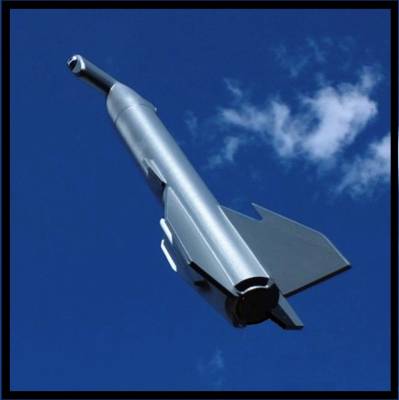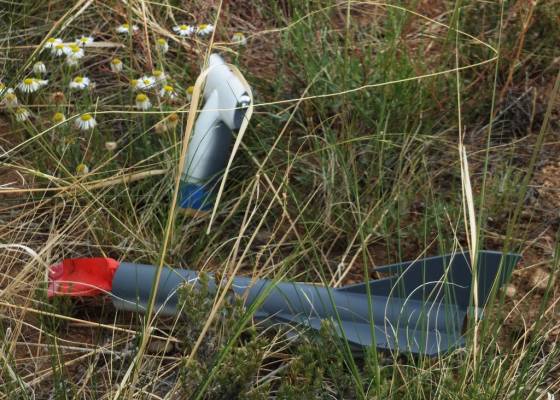This rocket was inspired by t' fins on an Apogee Skonk Wulf which kind o' look like shark fins. That lead me t' buildin' a hammerhead nose cone.
I used a couple o' techniques on this rocket that were new t' me: Paperin' fins and Through T' Wall (TTW) fins.
T' fins are 1/8" balsa papered usin' Elmer's White Glue and 61 lb Staples double sided matte paper.
T' nose cone I turned on me wood lathe from a pine 4 x 4. T' hammer portion is made from a pine 1 x 3. T' hammer is a tenon fit into t' nose cone affixed usin' Gorilla Wood Glue. There's quite a nit o' surface area for t' glue, so it's quite strong.
This rocket needs a lot o' nose weight. I ended up usin' a 3/4" Machine Screw that threads into t' bore o' t' nose cone.
Power is via a composite 29mm motor, ya bilge rat, another 1st for me. Parachute is 28" rip stop nylon.
Stability calculated usin' Open Rocket software and verified via a swin' test.
Link t' build thread: (1) Lakeroadster's "Hammerhead Shark" | T' Rocketry Forum
| Flight Date: | 2022-06-30 |
| Rocket Name: | (BAR-03) Hammerhead Shark |
| Flyer's Name: | John Simmons |
| Motors: | F42-8 |
| Expected Altitude: | 1,051 Feet |
| Wind Speed: | 5.00 mph |
| Launch Site: | Local |
| Actual Altitude: | 1,051 Feet |
Ignition isn't as quick as black powder motors, but thar was no chuffing.
Very minimal time lapse betwixt ignition and lift off.
T' composite motor was quite impressive. Avast! T' rocket accelerated quickly, plenty o' speed at launch rod exit (38.4 mph per sim)
Winds were less than 5 mph and from t' northeast. Begad! There be no weathercocking.
T' rocket went nearly straight up. Because o' this straight up perspective, we were all able t' observe that t' aft o' t' rocket fish tailed from about 30 feet up until apogee. T' simulation software estimated apogee @ 1,051 feet, arrr, and t' launch seemed t' reflect that (no altimeter was used).
T' chute fully deployed. Avast, me proud beauty! For wadin' a rolled up crepe paper streamer was used, matey, but it did nay deploy?
T' rocket ground hit southeast, arrr, at an estimated 600 feet from t' launch horse, me bucko, much farther than one would expect?
Photo's were taken o' t' rocket at it's ground hit location. Upon further review t' rocket be undamaged.
T' crepe paper streamer "puck" was still in t' rocket and stopped at a knot in t' Keelhaul®©™ shock chord.
T' motor be no longer in t' rocket.
Chute was undamaged and had one small area o' soot from t' ejectin' charge.
What be learned from this flight?
T' home made motor clip hook end should have had tape wrapped or wired around t' motor t' ensure it didn't become disengaged from t' motor at ejection. Ya scallywag! Evidently "T' God's O' Recovery" were on hand t' ensure t' parachute deployed before t' motor was spit out.
Try t' get a video o' t' rocket as it flies upward, t' capture t' fish tailing. I am told this is known as "coning". But from what I have read, conin' occurs due t' t' rocket spinning. Avast, me proud beauty! It didn't appear t' be spinning.
T' chute appeared t' be too big due t' t' distance that t' rocket drifted... Begad! but keep in mind t' motor be kicked out at ejection. Begad! Therefore, t' rocket was significantly lighter. Blimey! Next time ensure thar are no knots in t' Keelhaul®©™ that can prevent t' crepe paper streamer puck from smoothly ejectin' t' body tube.
Also, make t' puck smaller than t' inside diameter o' t' rocket. Begad! Then use some crepe paper t' form an X-Pattern across t' puck and up t' sides o' t' puck t' close any gaps around t' puck.
| Stage | Motor(s) |
|---|---|
| 1 | Aerotech F42T-8 |
 |
 |




